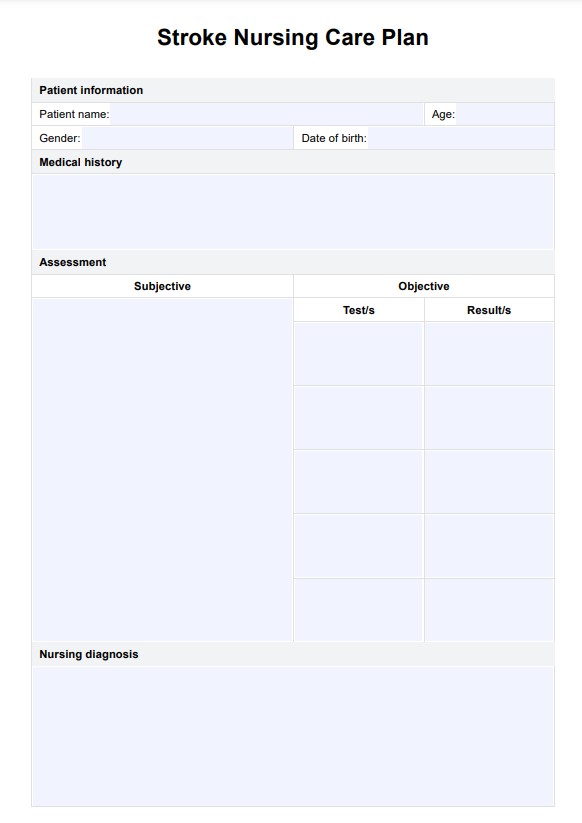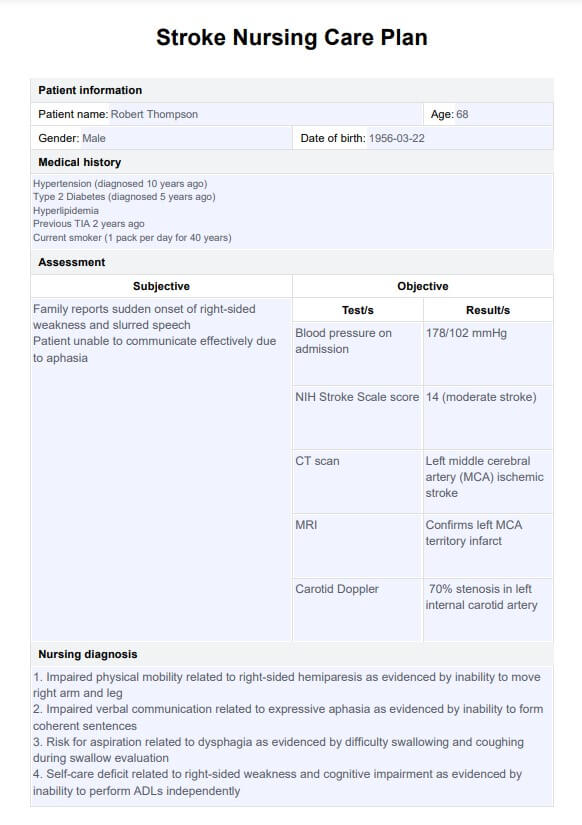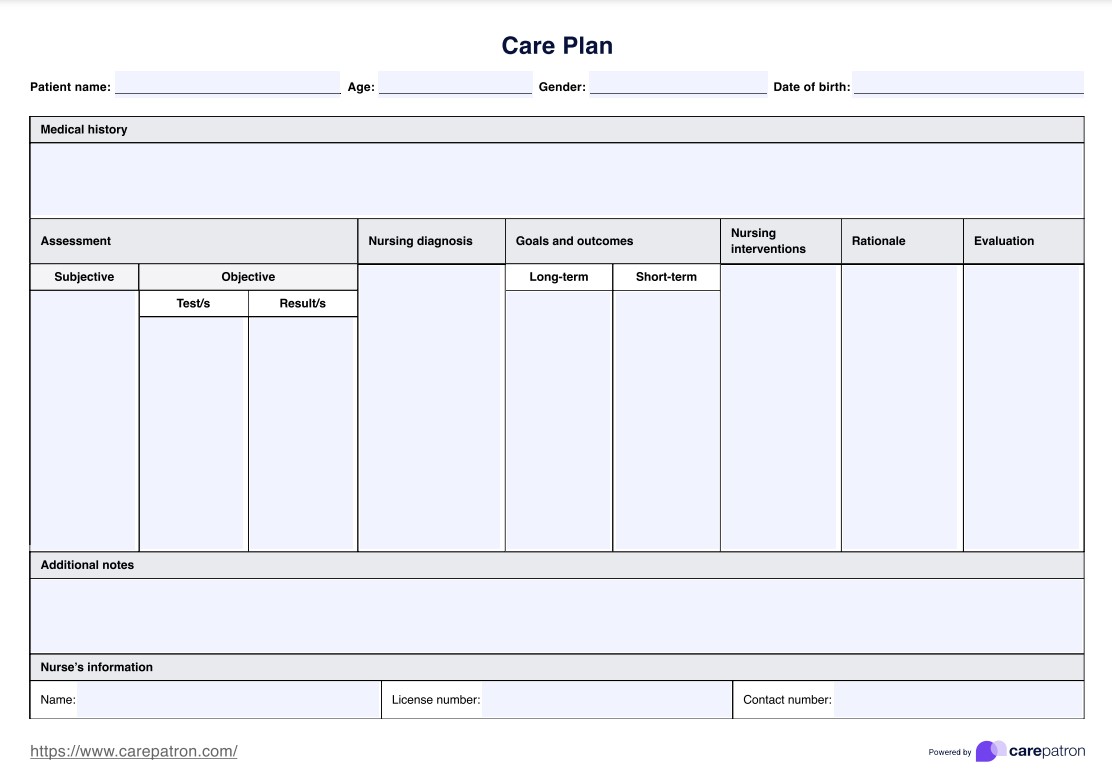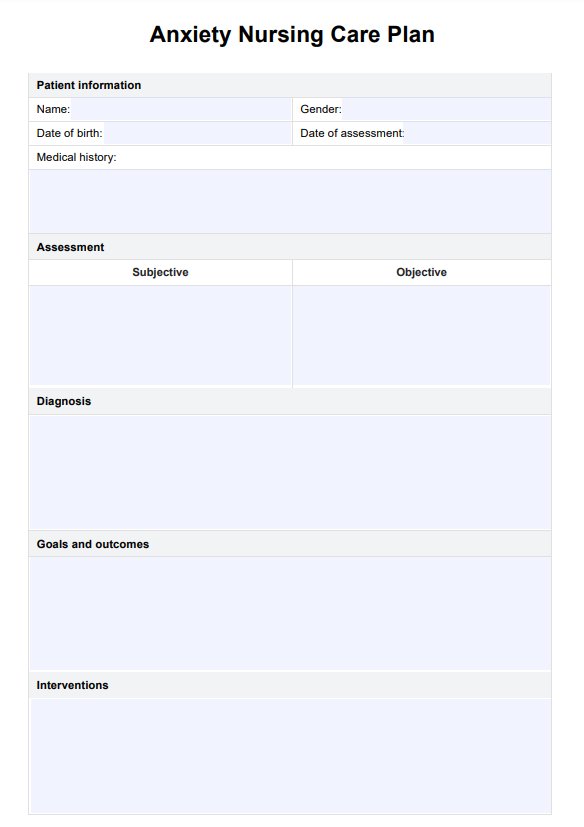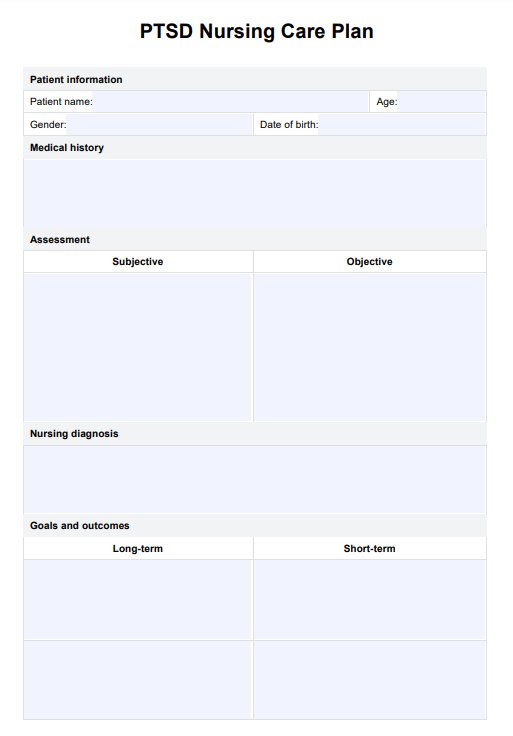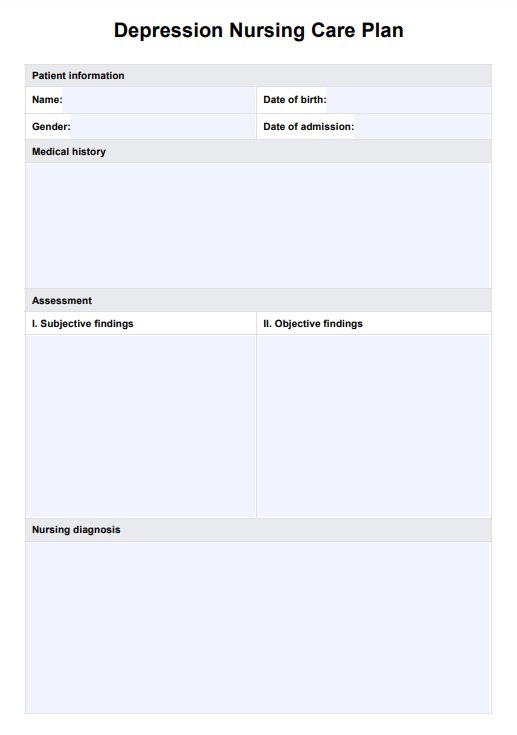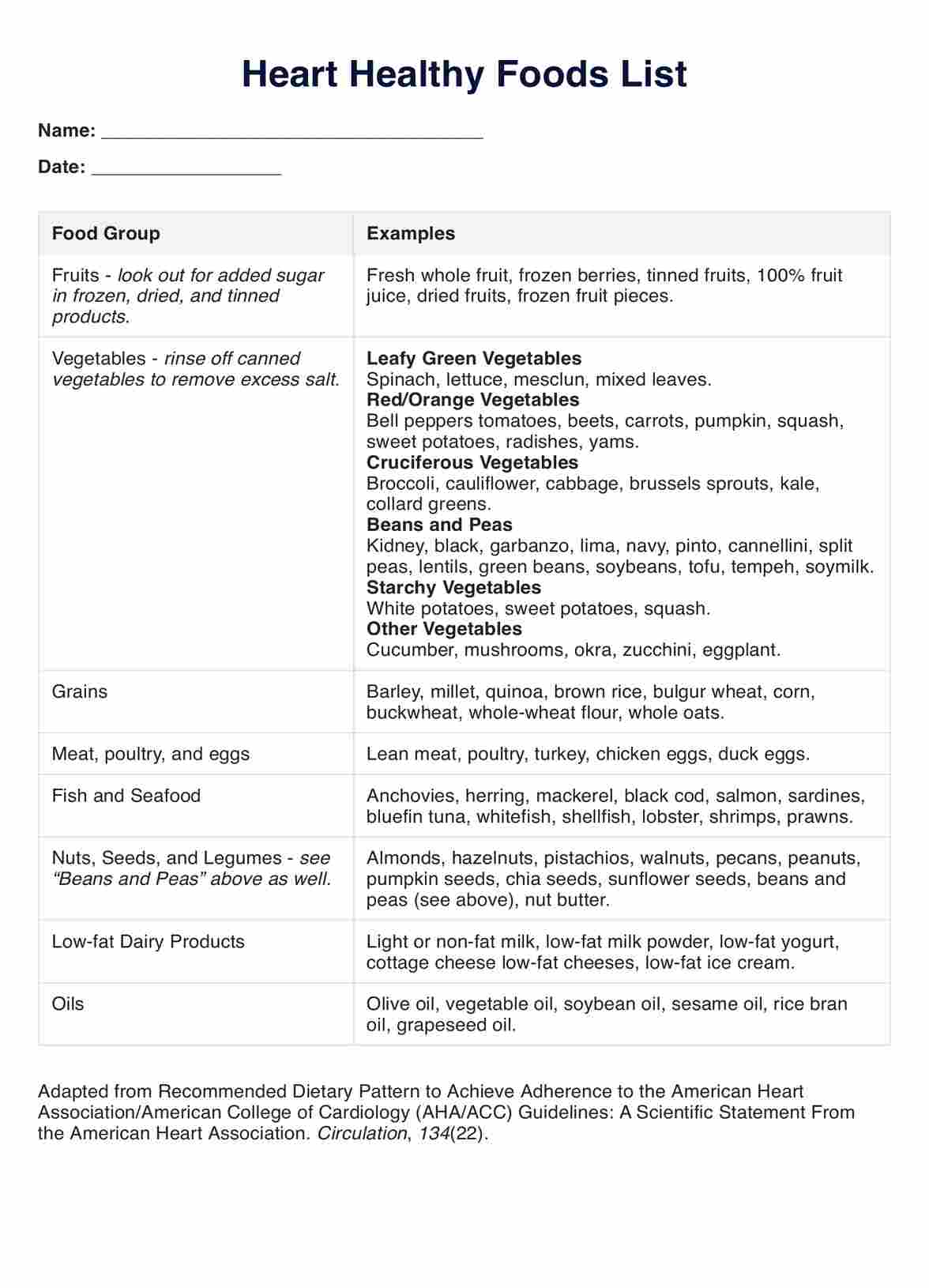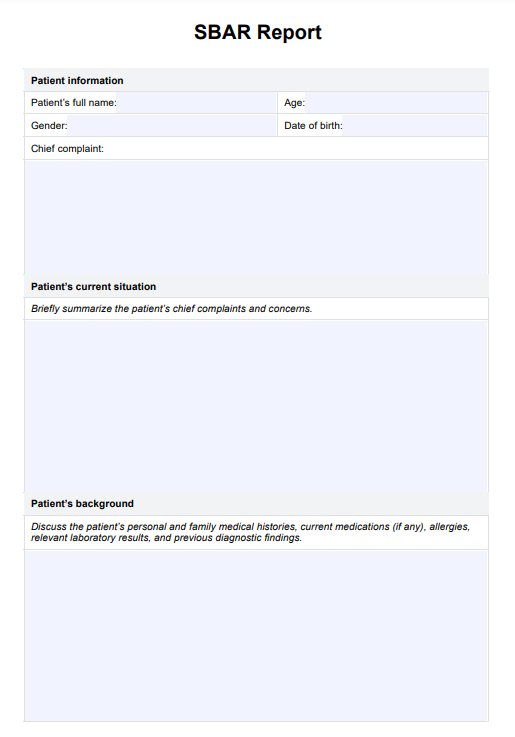Stroke Nursing Care Plan
Explore the value of a comprehensive Stroke Nursing Care Plan Template in providing care to stroke patients.


Understanding strokes
A cerebrovascular accident, commonly referred to as a stroke, is a medical event that occurs when blood flow to the brain is compromised. The event can be classed into either an ischemic stroke, where a clot blocks the blood flow to the brain, or a hemorrhagic stroke, where there is a burst artery causing sudden bleeding in the brain. This may occur as a result of an aneurysm, high blood pressure, or trauma. Blockages that dissolve before causing major damage are referred to as transient ischemic attacks, and a patient who has had these in the past may be at a higher risk of having a stroke in the future.
Stroke Nursing Care Plan Template
Stroke Nursing Care Plan Example
What is a Stroke Nursing Care Plan Template?
A nursing care plan for stroke is a comprehensive outline of interventions and strategies designed to support patients affected by a stroke. It aims to promote recovery, prevent complications, and enhance their overall well-being.
Since immediate nursing interventions following a stroke are crucial to stabilizing the patient and preventing further damage, a stroke patient nursing care plan that can streamline the evaluation and result recording process is especially helpful. In it, one can find adequate space to write vital signs and neurological status that can help identify the stroke's type and location and the timely actions done, such as providing oxygen if needed and monitoring for any signs of deterioration during the acute phase.
This nursing care plan for stroke patient PDF is essential in providing comprehensive, holistic, patient-centered care. It addresses acute medical needs, supports recovery and rehabilitation, prevents complications, and empowers stroke patients and their families with the knowledge and tools needed for optimal recovery and long-term stroke management.
How does our template work?
To ensure that you make the most out of our nursing care plan for stroke patient template, here's a step-by-step on how to use our resource:
Step 1: Gather your resources
Stroke nursing care plans are valuable resources and essential to keep on hand. Make sure that you have a copy of the free printable PDF by either clicking the “Download Template” or “Use Template” button or by searching “Stroke Nursing Care Plan” in Carepatron's template gallery's search bar on the website or app.
Step 2: Patient information and medical history
Begin by filling in the patient's basic information, including name, age, gender, and date of birth. Then, document the patient's relevant medical history in the provided space. This will help you understand the patient's background and potential risk factors.
Step 3: Fill out the assessment section
Complete the assessment section by recording both subjective and objective data. This comprehensive assessment helps identify the patient's current status and specific needs related to their stroke.
Step 4: Document nursing diagnosis, goals, and interventions
Based on the assessment data, formulate appropriate nursing diagnoses. Then, establish both long-term and short-term goals for the patient's care. Following this, outline specific nursing interventions along with their rationales.
Step 5: Evaluation and additional notes
Use the evaluation section to document the patient's progress toward the established goals. Finally, add any additional notes that may be relevant to the patient's care but don't fit into the other sections. Complete the form by filling in the nurse's information for accountability.
Factors to consider during the assessment
The results of a stroke can vary widely based on several factors, all of which should be considered and included within the care plan. The results of a stroke encompass a wide spectrum, ranging from mild, temporary symptoms to severe, lasting disabilities. During the assessment, nurses must consider including information on the following factors in the stroke care plan:
- Severity: The severity of a stroke determines its impact on the individual. A mild stroke might result in temporary weakness or speech difficulties, while a severe stroke can cause significant disability or even death.
- Location: The area of the brain affected by the stroke influences the resulting symptoms. For instance, a stroke affecting the motor area might lead to weakness or paralysis on one side of the body.
- Complications: Stroke survivors might face long-term complications such as muscle weakness, cognitive impairments, difficulty swallowing (dysphagia), depression, or increased risk of future strokes.
- Recommended recovery and rehabilitation: Some individuals experience partial or complete recovery from stroke symptoms. The extent of recovery varies among individuals and depends on factors like age, overall health, and the promptness of treatment.
- Possible quality of life: Stroke outcomes profoundly affect a person's quality of life. While some individuals regain independence and resume most activities, others might require ongoing assistance with daily tasks or experience limitations in mobility, communication, or cognition.
- Prevention and lifestyle changes: Stroke often prompts lifestyle modifications and preventive measures to reduce stroke risk. These might include changes in diet, exercise, medication adherence, and managing underlying health conditions like hypertension or diabetes.
When would you use this template?
A Stroke Nursing Care Plan Template is implemented across various stages of stroke care and can be applied in multiple settings, some of which are outlined below:
Acute care
A nursing plan is crucial immediately following an acute ischemic stroke, a subset of ischemic strokes, in emergency departments or intensive care units. It provides information on stabilizing the patient and monitoring vital signs, which are needed before nurses provide acute interventions like deep vein thrombosis (DVT) to prevent further damage or complications.
Inpatient rehabilitation
For stroke survivors admitted to specialized rehabilitation units, a care plan guides nurses in facilitating recovery through mobility exercises, therapies, and ongoing monitoring to improve functional abilities and regain independence.
Long-term care facilities
Patients who require extended care due to health implications and changes post-stroke benefit from tailored care plans in long-term care settings. These plans aim to maintain quality of life, prevent complications, and provide ongoing rehabilitation.
Outpatient or home care
Once discharged, stroke survivors often receive care at home or through outpatient services. Nursing care plans help transition from the hospital to home by guiding medication management, rehabilitation exercises, lifestyle modifications, and monitoring for any signs of complications.
Preventive care and education
Nursing care plans are also utilized in stroke prevention programs. Nurses educate at-risk individuals about lifestyle changes, preventive measures to reduce the likelihood of future strokes, and modifiable risk factors like hypertension, cardiac dysrhythmias, obesity, smoking, poor control of diabetes, and oral contraceptive use. This can also address the risk of skin breakdown and other injury when the patient's sensory awareness is affected.
Family and caregiver support
Care plans extend to supporting and educating family members and caregivers. This patient and partner focus can improve how the patient's needs are addressed and how care is provided at home. This can also allow household members to recognize signs of complications and access resources for continued support.
Commonly asked questions
To create a comprehensive nursing care plan for stroke management, simply create a customized plan from the template provided by Carepatron and cater to the patient's needs through the key aspects of assessment, diagnosis, planning, intervention, and evaluation.
These valuable plan templates can be used at any point in the treatment journey for a stroke patient to track, monitor, and plan all interventions by healthcare professionals and the patient themselves.
Stroke Nursing Care Plan Templates are used as a planning tool for efficient and confident care delivery. They are designed to be customized to meet the individual patient's needs.


